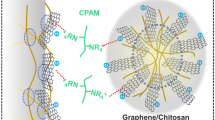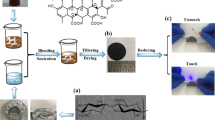Abstract
Nanofibrillated cellulose (NFC) has received significant attention in materials science recently because of its unique properties such as high mechanical properties, high surface area, and applicable rheology. NFC-based papers possess high mechanical strength and excellent oxygen barriers. However, they exhibit poor mechanical properties in high-humidity environments because of their hydrophilicity, thus narrowing its applications. In this study, we demonstrated that an incorporation of chemically reduced graphene oxide (RGO) sheets into NFC paper resulted in significantly improved mechanical properties in high-humidity condition. Dynamic mechanical analysis showed that all NFC/RGO composite papers containing graphene ranging between 1 and 10 wt% were not broken in an extreme test condition at 80 °C and 80 % relative humidity. Meanwhile, neat NFC paper was broken when the temperature reached 50 °C. In addition, the tensile test demonstrated that Young’s modulus of the NFC/RGO composite paper was significantly higher than that of neat NFC paper. Furthermore, the NFC/RGO composite papers possessed high electrical conductivity, which was proportionally increased as the graphene loading content increased. The developed NFC/RGO composite materials can find potential uses as conductors, antistatic coatings, and electronic packaging, especially where high moisture is present.
Graphical Abstract









Similar content being viewed by others
References
Boujemaoui A, Carlsson L, Malmström E, Lahcini M, Berglund L, Sehaqui H, Carlmark A (2012) Facile preparation route for nanostructured composites: surface-initiated ring-opening polymerization of ε-caprolactone from high surface-area nanopaper. ACS Appl Mater Interfaces 4(6):3191–3198. doi:10.1021/am300537h
Bunch JS, Verbridge SS, Alden JS et al (2008) Impermeable atomic membranes from graphene sheets. Nano Lett 8:2458–2462. doi:10.1021/nl801457b
Chua CK, Pumera M (2014) Chemical reduction of graphene oxide: a synthetic chemistry view point. Chem Soc Rev 43:291–312. doi:10.1039/c3cs60303b
Han D, Yan L, Chen W et al (2011) Cellulose/graphite oxide composite films with improved mechanical properties over a wide range of temperature. Carbohyd Polym 83:966–972. doi:10.1016/j.carbpol.2010.09.006
Henriksson M, Berglund LA, Isaksson P, Lindstöm T, Nishino T (2008) Cellulose nanopaper structure. Biomacromolecules 9:1579–1585. doi:10.1021/bm800038n
Hummers WS Jr, Offeman RE (1958) Preparation of graphitic oxide. J Am Chem Soc 80(6):1339. doi:10.1021/ja01539a017
Kim H, Abdala AA, Macosko CW (2010) Graphene/polymer nanocomposites. Macromolecules 43(16):6515–6530. doi:10.1021/ma100572e
Kim CJ, Khan W, Kim DH et al (2011) Graphene oxide/cellulose composite using NMMO monohydrate. Carbohyd Polym 86:903–909. doi:10.1016/j.carbpol.2011.05.041
Laaksonen P, Walther A, Malho JM et al (2011) Genetic engineering of biomimetic nanocomposites: diblock proteins, graphene, and nanofibrillated cellulose. Angew Chem Int Edit 50:8688–8691. doi:10.1002/anie.201102973
Lee C, Wei XD, Kysar JW, Hone J (2008) Measurement of the elastic properties and intrinsic strength of monolayer graphene. Science 321:385–388. doi:10.1126/science.1157996
Li D, Muller MB, Gilje S, Kaner RB, Wallace GG (2008) Processable aqueous dispersions of graphene nanosheets. Nat Nanotech 3:101–105. doi:10.1038/nnano.2007.451
Luong ND, Pahimanolis N, Hippi U, Korhonen JT, Ruokolainen J, Johansson L-S, Nam JD, Seppälä J (2011) Graphene/cellulose nanocomposite paper with high electrical and mechanical performances. J Mater Chem 21:13991–13998. doi:10.1039/C1JM12134K
Luong ND, Korhonen JT, Soininen AJ, Ruokolainen J, Johansson LS, Seppälä J (2013) Processable polyaniline suspensions through in situ polymerization onto nanocellulose. Eur Polym J 49(2):335–344. doi:10.1016/j.eurpolymj.2012.10.026
Mahmuodian S, Wahit MU, Imran M et al (2012) A facile approach to prepare regenerated cellulose/graphene nanoplatelets nanocomposite using room-temperature ionic liquid. J Nanosci Nanotechno 12:5233–5239. doi:10.1166/jnn.2012.6351
Malho JM, Laaksonen P, Walther A et al (2012) Facile method for stiff, tough, and strong nanocomposites by direct exfoliation of multilayered graphene into native nanocellulose matrix. Biomacromolecules 13:1093–1099. doi:10.1021/bm2018189
Mayorov AS, Gorbachev AV, Morozov SV, Britnell L, Jalil R, Ponomarenko LA, Blake P, Novoselov KS, Watanabe K, Taniguchi T, Geim AK (2011) Micrometer-scale ballistic transport in encapsulated graphene at room temperature. Nano Lett 11:2396–2399. doi:10.1021/nl200758b
Moon RJ, Martini A, Nairn J, Simonsen J, Youngblood J (2011) Cellulose nanomaterials review: structure, properties and nanocomposites. Chem Soc Rev 40:3941–3994. doi:10.1039/C0CS00108B
Novoselov KS, Fal’ko VI, Colombo L, Gellert PR, Schwab MG, Kim K (2012) A road map for graphene. Nature 490:192–200. doi:10.1038/nature11458
Pääkkö M, Ankerfors M, Nykänen A, Ahola S, Östergerg M, Ruokolainen J, Laine J, Larsson PT, Ikkala O, Lindström T (2007) Enzymatic hydrolysis combined with mechanical shearing and high pressure homogenization for nanoscale cellulose fibrils and strong gels. Biomacromolecules 8(6):1934–1941. doi:10.1021/bm061215p
Pinkert A, Marsh KN, Pang S, Staiger P (2009) Ionic liquids interaction with cellulose. Chem Rev 109(12):6712–6728. doi:10.1021/cr9001947
Potts JR, Dreyer DR, Bielawski CW, Ruoff RS (2011) Graphene-based polymer nanocomposites. Polymer 52(1):5–25. doi:10.1016/j.polymer.2010.11.042
Seppälä J (2012) Nanocellulose: a renewable polymer of bright future. Express Polym Lett 6(4):257. doi:10.3144/expresspolymlett.2012.28
Siro I, Plackett D (2010) Microfibrillated cellulose and new nanocomposite materials: a review. Cellulose 17:459–494. doi:10.1007/s10570-010-9405-y
Stankovich S, Dikin DA, Dommett GHB, Kohlhaas KM, Zimney EJ, Stach EA, Piner RD, Nguyen SBT, Ruoff RS (2006a) Graphene-based composite materials. Nature 442:282–286. doi:10.1038/nature04969
Stankovich S, Piner RD, Nguyen SBT, Ruoff RS (2006b) Synthesis and exfoliation of isocyanate-treated graphene oxide nanoplatelets. Carbon 44(15):3342–3347. doi:10.1016/j.carbon.2007.02.034
Yamashiki T, Matsui T, Saitoh M, Matsuda Y, Okajima K, Kamide K (1990) Characterization of cellulose treated by the steam explosion method. Part 3: effect of crystal forms (Cellulose I, II, and III) of original cellulose on changes in morphology, degree of polymerization, solubility and supramolecular structure by steam explosion. Brit Polym J 22:201–212. doi:10.1002/pi.4980220305
Zhao X, Zhang Q, Chen D (2010) Enhanced mechanical properties of graphene-based poly(vinyl alcohol) composites. Macromolecules 43(5):2357–2363. doi:10.1021/ma902862u
Acknowledgments
The authors acknowledge the Laboratory of Inorganic Chemistry of Aalto University for access to the X-ray diffraction equipment and Dr. Markus Valkeapää for his assistance with the measurements. This work made use of the facilities of the Nanomicroscopy Center at Aalto University (Aalto-NMC). The work was partly carried out as part of the project Tailoring of Nanocellulose Structures for Industrial Applications (NASEVA) funded by the Finnish Funding Agency for Technology and Innovation (TEKES). Dr. Steve Spoljaric at Aalto University is acknowledged for the valuable discussion of the DMA results.
Author information
Authors and Affiliations
Corresponding author
Electronic supplementary material
Below is the link to the electronic supplementary material.
Rights and permissions
About this article
Cite this article
Nguyen Dang, L., Seppälä, J. Electrically conductive nanocellulose/graphene composites exhibiting improved mechanical properties in high-moisture condition. Cellulose 22, 1799–1812 (2015). https://doi.org/10.1007/s10570-015-0622-2
Received:
Accepted:
Published:
Issue Date:
DOI: https://doi.org/10.1007/s10570-015-0622-2




